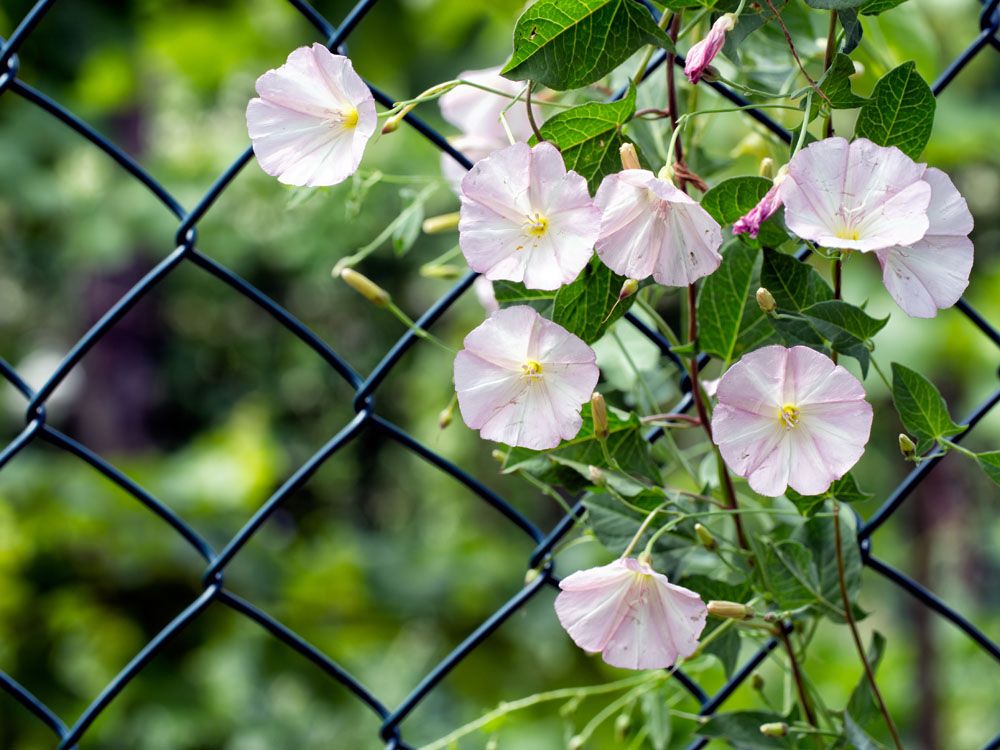
Field bindweed
Field Bindweed: A Complete Guide -Prevention and Control-
Bindweed is a widespread kind of perennial climbing weed. This noxious weed is well-known for its capacity to suffocate existing garden plants and overrun boundaries in as little as 2-4 months. Their roots may reach 7 meters deep and grow vigorously, as any gardener who has had the misfortune of having it grow in their garden can attest.
Field bindweed is a member of the morning-glory family and shares vine traits with it. The large root structure and creeping growth tendency result in thick, tangled infestations. The size and form of the leaves vary, but they are typically 1 to 2 inches long and sagittate. Flowers are tubular or bell-shaped and normally white, with a pale pink pattern on occasion. Field bindweed is distinguished from hedge bindweed by its tiny bracts, leaf form, and modest bloom size.
Identification
Bindweed is sometimes known as wild morning glory because it resembles morning glory’ in appearance. These features include a narrow stem, elongated leaves fashioned like ‘arrowheads,’ and trumpet-like blooms that come in pink and white. The thin vines becoming firmly entwined with other plants or other rising items in the garden are generally the first indicators of bindweed.
Effects/ Impact
Field bindweed is a persistent and difficult-to-control weed in agricultural crops. Its seed has a long dormancy period and can survive in the soil for up to 60 years. It has a climbing behavior that permits it to grow taller. Furthermore, rhizomes have the potential to permeate cloth, plastic, and other obstacles. Field bindweed is also drought resilient and difficult to manage once established, even with herbicides. Field bindweed reduces the value of land and prevents the establishment of numerous agricultural crops.
Bindweed seeds can remain latent in the soil for several years, and new plants can sprout from even the tiniest segment of the root. Bindweed root pieces are frequently transported into the garden unintentionally amid the roots of other plants or in soils and manures. Bindweed may spread two meters wide in a single growing season if it is there.
Prevention and Control
Field Bindweed is tricky to handle and eliminate owing to its vast root system and lengthy seed life. The secret to effective management is depleting the plant’s root stores and decreasing sprouting. Whatever management strategies are chosen, they will need time and perseverance. For effective management, an Integrated Pest Management plan must include more than one approach. Prevention is the most effective and cost-effective management strategy. Well-established perennial lawns and vegetation on a well-managed pasture with adequate grazing strategies will help avoid its development.
Hand pulling seedling or young adult stage plants, hoeing, tilling, or cultivating can all be efficient mechanical ways. During the growth season, mechanical procedures must be performed every two weeks. Mowing has been ineffective as a management method while burning has had minimal impact. Field Bindweed may be controlled using a variety of chemical treatments. Chemical weed treatment is frequently the best approach for turf weed control. There are organic weed management solutions, but none are selective. All organic chemical alternatives are non-selective, which means they will inhibit or kill any plant with which they come into contact.
